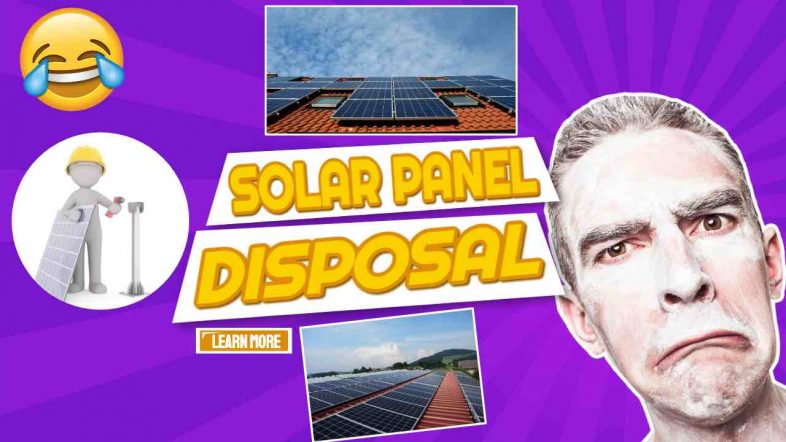Solar Panel Disposal is not yet a big issue. Most solar panels in use are still relatively new. But in the years to come “how to dispose of the photovoltaic cells” will become very important. That’s why we bring you our Quick Guide here.
The current global rate of solar panel disposal, which the International Renewable Energy Agency (IRENA) estimated at circa 250,000 metric tonnes of solar panel waste in 2016 is already noteworthy. Nevertheless, it is tiny compared with the 78 million metric tonnes IRENA has projected this amount may reach in 2050.
78 million tonnes might sound a lot, but in reality, is only a small part of the total e-waste man’s activities are now producing annually.
What is a bigger concern is that for the energy-producing core of each panel, the photovoltaic cell, the standard methods used today – namely those employed for general electronics recycling – are inadequate. And, that’s in parts of the world where e-waste is collected separately from other wastes. Most of the global population does not have the infrastructure to recycle general e-waste, let alone apply special measures to the disposal of solar cells.
Solar Industry Still a Long Way Off Meeting True Sustainability Goals
Current methods in use in e-waste MRFs are inadequate. Normal practice is not to split down each solar panel element sufficiently for efficient reuse of all each material. All that is done is to cherry-pick them to remove and recycle the parts of most value, such as copper wire, junction boxes, metal frameworks, and often also the glass. The rest goes to landfill or incineration.
New techniques will be needed for truly sustainable solar panel disposal. Many people are calling for the solar panel industry to step in now, develop these techniques now, and take full responsibility for the full cost of the environmental disposal of their products.
Meanwhile, solar panels are an increasingly vital source of renewable power that will help to decarbonize the world role and win the battle against climate change. Society is grateful. But, their proponents of solar energy need to take very seriously the use of materials such as silver, and rare earth’s, from the point of view of their reuse and limited global availability.
We are confident that the technology will improve, and that future photovoltaics will get lighter/ consume fewer materials and last for longer. It is important that they also use far less copper cabling than today, and reduce the amount of soldering which uses finite resources of tin and lead.
Now read on for our quick guide to solar panel disposal:

Solar Panel Disposal: A Quick Guide:
Solar power is becoming more affordable as the call to switch to renewable energy is being heard. Photovoltaic cells are reliable and do not require a lot of maintenance to work optimally and keep in shape. Unless they incur damage due to a freak storm, they will serve your household or business for years. A high-quality installation could provide all the electricity needs of a household, and gain the family significant savings in monthly utility bills.
Life Expectancy
The expected life expectancy of a solar installation is about 25 to 30 years, which pertains to the length of time they are expected to produce maximum power. Energy production decreases after the determined life expectancy, however, they will still produce electricity.
There are factors influencing the degradation rate of a solar panel, including the brand. The average rate per year is 0.5%t. The known degradation rate ranges from 0.3% per year to 0.8% per year.
Solar Panel Recycling
The more common type of solar panel is silicon-based. The recycling processes for photovoltaic cells are very efficient. All the metal components are reused as well as most of the glass parts. Meanwhile, the silicon waters can be melted down and used again to fabricate new modules. The recycling rate for silicon is about 85%.
Thin-film-based panels are different in composition from silicon panels, and they are shredded into very small particles. The solid particles are separated from the liquid components. The liquid component then goes through processing to retrieve the semiconductors, of which about 95% is reused. Meanwhile, the solid components are rinsed and the pure glass retrieved is used for manufacturing.
Dismantling solar panels for recycling must only be done in a certified facility by qualified individuals. The manufacturing of panels may use hydrofluoric acid, which is a caustic chemical.
While there are no established solar panel recycling infrastructures in the Philippines, speciality recycling facilities that deal with electronics waste also process decommissioned solar panels. It is essential that a potential investor in solar panel systems also consider solar panel waste management currently available. In a decade or two, we can expect solar panel recycling facilities to be more common due to the increasing demand as larger volumes of modules are expected to be disposed of in the future.
Solar Panel Repair
When faulty, solar panels will have a diminished yield. Instead of purchasing a replacement, it’s possible to have them repaired.
Hot spots and microscopic fractures are common issues on the surface of the panel.
Other problems encountered are voltage fluctuations and loose wiring. Inner module wiring issues may arise as well.
The installation company should be the first to approach should any of these issues arise.
A homeowner may check the contract signed prior to the installation in order to determine which repair issues are covered by the warranty and which are not.
Solar panel maintenance is an essential aspect of utilizing solar energy in your business establishment or household. It pays to know how and where you can go for repairs and the available options for waste management.
Where to Dispose of Solar Panels
 The question of where to dispose of solar panels varies according to the availability of first of all e-waste collection and specialist disposal. In Europe, the answer is that anyone who has solar panels to dispose of should not simply dump them at a landfill. They should, if there is a local facility, be taken to a solar panel recycler as a first choice. If there are none, they should be taken to a recycling facility that accepts e-waste. If there is no e-waste recycling available disposal to an incinerator, or landfill should be seen as the last resort.
The question of where to dispose of solar panels varies according to the availability of first of all e-waste collection and specialist disposal. In Europe, the answer is that anyone who has solar panels to dispose of should not simply dump them at a landfill. They should, if there is a local facility, be taken to a solar panel recycler as a first choice. If there are none, they should be taken to a recycling facility that accepts e-waste. If there is no e-waste recycling available disposal to an incinerator, or landfill should be seen as the last resort.
Are solar panels toxic to dispose of?
Solar panel disposal toxic content is low and is restricted to the heavy metal “rare earths” they contain. Silicon is an abundant element and will do no harm when released back into the environment. Unfortunately, although solar panels are not “toxic” in the sense that they contain a poison capable of killing people exposed to the waste, the metals they contain do possess “toxicity”.
The metals, such as cadmium, lead and tin (from solder) and copper from cables, when subjected to acidic conditions become soluble and dissolve. Once that happens they are all “toxic” if present even at low levels in watercourses, and if found in groundwater will eventually get into surface watercourses. Acidic conditions occur in landfills in the early (acidogenic) stages of decomposition. It is also possible that acidic conditions may return eventually to today’s modern landfills.
If solar panels are thrown into landfills, one day they will release their metal content and there will be toxicity released and environmental damage. For a well-engineered modern landfill, this may not happen for 200 or more years, but eventually, it will occur.
How Much Does Solar Panel Disposal Cost?
The solar panel disposal cost to you as an owner of old solar panels to dispose of depends on how you dispose of it, according to your local waste management regulations.
You may be permitted to take your solar panels to a landfill and simply tip the material there. If so the solar panel disposal cost will be the charge made at the landfill, plus any costs of getting your waste to the landfill
If there are regulations requiring e-waste to be separately collected and processed at e-waste facilities under producer responsibility regulations which apply, as in Europe for example, you will be charged the local rate for e-waste if seeking commercial disposal. As a homeowner seeking disposal, the cost may be covered by your rates, if within the EU.
The disposal cost of solar panels to a high standard of sustainability with a high percentage of separation and reuse/ recycling is high. Using currently available methods to separate the solar panel parts is labour intensive. It has to be done by hand. The panels need to be dismantled and comprehensively disassembled. Only then can sorting take place and the electronic surface boards and the plastics and silicon embedded light cells be shredded for incineration to melt out the metals.
There is no commonly available industry standard price for solar panel sustainable disposal as e-waste.
Solar Panel Disposal Regulations
We don’t know of any specific solar panel disposal regulations in theUK, beyond that photovoltaics should be dealt with as you would responsibly dispose of any e-waste.






Extremely educational post! This post gives really quality data. I’m now done it and observe that this post is truly amazing.